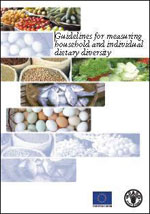
Guidelines
for measuring household
and individual dietary diversity
Download Full Report  [1Mb]
[1Mb]
 |
Download Full Report |
|
|
|
ABSTRACT Obtaining detailed data on household food access or individual dietary intake can be time consuming and expensive, and requires a high level of technical skill both in data collection and analysis. Dietary diversity is a qualitative measure of food consumption that reflects household access to a variety of foods, and is also a proxy for nutrient adequacy of the diet of individuals. The dietary diversity questionnaire represents a rapid, user-friendly and easily administered low-cost assessment tool. Scoring and analysis of the information collected with the questionnaire is straightforward. The dietary diversity scores described in these guidelines consist of a simple count of food groups that a household or an individual has consumed over the preceding 24 hours. The guidelines describe the use of the dietary diversity questionnaire at both the household and individual level, for which calculation of the score is slightly different in each case. The data collected can also be analyzed to provide information on specific food groups of interest. The rationale for these guidelines is to provide a standardized questionnaire of universal applicability from which various dietary diversity scores can be calculated. As such it is not culture, population, or location specific and therefore, prior to using it in the field, it will be necessary to adapt it to the local context. The guidelines describe how to adapt and use the dietary diversity questionnaire, how to calculate each of the scores and how to create other indicators of interest from dietary diversity data. |
|
The views expressed in this information product are those of the author(s) and do not necessarily reflect the views of FAO.
Chief
|
© FAO 2012